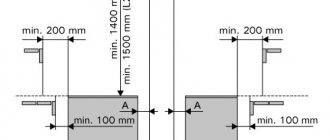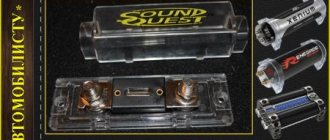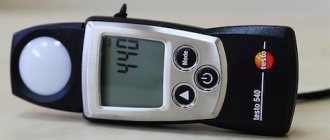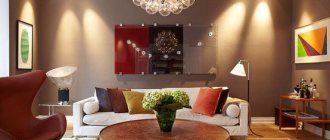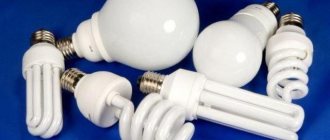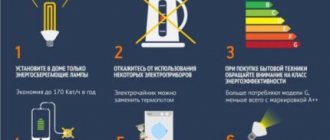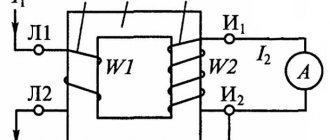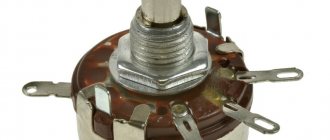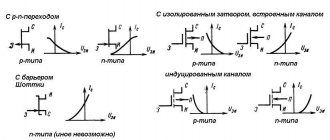From this article you will learn how to use a lux meter, why you need to take measurements and what measures need to be taken to ensure that the lighting of your workplace, apartment, country house, cottage and other places of residence complies with sanitary standards. We will look at measuring ripple factor, illumination and brightness - the conditions under which it is necessary to determine these parameters, as well as their effect on the human body.
Purpose and principle of operation of a lux meter
The main purpose of the device is to measure the level of illumination at the required point in space.
Where a lux meter is used, you can easily adjust this indicator, which depends on:
- number of light sources, including artificial and natural;
- light pressure of each source;
- distance between the measurement point and the light source;
- reflectivity of nearby surfaces.
The device is actively used in the following cases:
- To control sanitary standards for lighting in residential premises.
- To measure the level of illumination of workplaces, which allows maintaining comfortable working conditions and hygiene for workers.
- To control the illumination of premises in production areas, schools, libraries, medical institutions, museums, etc.
- For selecting the brightness of lamps in greenhouses and greenhouse farms where plants are bred and maintained.
- To determine the shooting exposure when taking photographs.
- To adjust the brightness of signal lights and illuminated advertising.
- As part of a pulse meter-brightness meter - to measure the degree of pulsation of the image of monitors and illumination in general, caused by the flickering of LEDs, fluorescent and energy-saving lamps.
- To check whether the actual illumination corresponds to the calculated level when installing lighting systems.
When the device operates, a luminous flux of a certain spectrum is converted into an electric current with the corresponding intensity characteristics of the first.
The results are displayed on the device screen.
Given how a lux meter works, it makes sense to use models that allow you to select the operating mode for a specific light spectrum.
Operating principle of the device:
• The electrons in a photocell made from a semiconductor are activated by light. The brighter the light flux, the more actively electrons are released.
• The throughput of the photocell changes, which is recorded by the electronics of the device, which, after processing by the processor, is displayed on the screen.
• The illumination meter in operation produces results, the correctness of which depends on the correct orientation of the sensor relative to the light flux.
Easily measure any light source
According to the standard manual, the sensor is installed horizontally in a specific work area. In multifunctional devices, select the desired mode. The results are read from the display or sent to a computer for software processing using a connecting cable.
Ripple is measured in ceiling and table lamps, laptop and smartphone screens, tablets and monitors. The photo sensor is placed as close as possible to the source after switching to the appropriate mode. Maintain the minimum recommended distance to prevent overheating (when working with incandescent lamps).
To prevent errors when measuring illumination with a lux meter:
- ensure sensor stability;
- prevent the parasitic influence of other light sources;
- exclude the movement of people, vibrations, and other interference.
Device and characteristics
The main element of a luxmeter is a semiconductor photocell that transfers the energy of light quanta to electrons.
The resulting electrical flow, depending on the type of device, is either converted by a galvanometer, provoking the movement of the pointer needle, or transformed by an optical-electronic converter into digital form, followed by display of the result on the display.
In other words, a classic lux meter consists of a converter and a photosensor, which can be made as a monoblock or as separate modules connected by wire.
Illumination levels are measured in lux, and the emission scale ranges from a tenth to several hundred thousand.
In this case, 1 lux corresponds to illumination of 1 lumen over an area of 1 square meter.
Accordingly, the unit of measurement of a light meter is lux, and lumens indicate the intensity of the light flux.
Material
The body of the portable device is made of durable and reliable plastic material.
For ease of holding, some models have rubberized pads.
In the case of a separate layout, the photo sensors are also hidden by a plastic housing.
Dimensions and weight
The weight of most portable light meters is 0.1 - 0.5 kg, depending on the size of the battery.
Approximate dimensions of devices:
- height: 80 – 200 mm (depending on the layout);
- width: 50 – 80 mm.
Accuracy, error and verification
The state verification scheme for lux meters is fully described in GOST 8.023-2014.
The initial verification of instruments included in the State Register of SI of the Russian Federation is carried out after their repair, or immediately before commissioning.
Periodic verification in most cases is performed once a year.
Includes checking the accuracy and all errors of the device.
Calibration, among other things, implies spectral correction of its photosensor.
High-quality installation in one click
“VideoMONTAZH” is an example of a simple editor that makes it possible to achieve good results. The main principle of the program is maximum simplification and speed in creating videos. Already at the beginning of work, you will notice that many processes are automated; editing a real film can take less than an hour.
To stitch together video tracks, just add them to the timeline, select transitions from the collection and save the result.
Similar simplicity applies to other editor features.
Video card in 5 minutes
“VideoMONTAGE” involves a special step-by-step mode for quickly creating congratulatory videos. Trim the video track, put a postcard on it, add a caption, voice over and save the result. The phrase “in 5 minutes” is quite arbitrary - most likely, you will finish it much faster.
Chromakey
The program makes it possible to overlay videos on top of each other with the replacement of a single-color background. This cinematic technology is also implemented in the editor in an extremely simple way - upload both video files, specify the background color - and voila, the magical video editing is complete.
Creating Effects
The program has a collection of filters. The effects are colorful tinting using highlights, film grain, vignettes and other elements. They will add atmosphere and style to the video sequence. In addition, “VideoMONTAZH” involves creating similar custom filters from scratch. Feel free to get creative!
Color correction and stabilization
It’s hard to imagine high-quality video editing without “technical” improvements. In "Video Montage" you can eliminate jitter in the frame, as well as correct errors when setting up the camera, such as incorrect white balance and exposure.
Adding screensavers and titles
You can work through the video from the first to the last frame. Place a catchy intro at the beginning, and informative credits at the end. Use blanks from the program’s collection or design the design manually by overlaying text on top of a picture or video.
As you can see, a video editing program will help not only turn the video in the right direction, but also significantly improve the quality of the picture and add attractiveness. If you are looking for a fast and powerful editor, then here is the right tip for you - download “VideoMONTAZH” and process videos to your heart’s content.
Types of lux meters and their prices
Lux meters can be used for their intended purpose both outdoors and indoors.
Structurally, they are divided into:
• Monoblocks – the sensor is fixed directly to its body. This option is convenient for making quick measurements, has less weight, however, it is not suitable for working in hard-to-reach places. Some models have a removable sensor, which expands their functionality.
• With a remote sensor – a more convenient option for taking measurements in places where it is difficult to get to. The sensitive sensor is connected to the main module with a flexible wire, which allows you to easily measure indicators from any direction. Such lux meters are preferable when assessing working conditions.
Depending on the type of indicator, devices are:
• Digital. The measurement results are displayed electronically on the device display. Such lux meters are easy to use and have relatively high accuracy.
• Pointer – the analog indicator has a pointer and a scale, the gradation of which is made in lux. The accuracy of the measurement indicators, compared to the previous version, is significantly lower.
The lux meter can have expanded functionality; according to its characteristics, the device can be:
• Household. Cheap models display only illumination; they are used for quick measurements that do not require high accuracy. More expensive options are capable of independently calculating the average illumination value based on several measurements. The design provides internal memory and an interface for connecting the device to a personal computer or laptop. The minimum price for the device is 1500 rubles.
• Professional – equipped with light filters, the spectral sensitivity of the photosensor, which is almost similar to the human eye. They make it possible to more effectively measure the properties of light fluxes of various color shades. Outdoor models are additionally equipped with special absorption filters that expand the measuring range in bright light. The measurement error is about 1%. The cost of professional models starts at 10 thousand rubles.
Often, professional lux meters are equipped with additional equipment that allows them to measure other characteristics of the luminous flux:
• Luxmeter-brightness meter. In addition to performing the functions of a lux meter itself, it is designed to measure the brightness of luminous objects. A high-quality device will cost 10 thousand or more rubles.
• Light meter-pulse meter. This device, in addition to measuring illumination, is capable of determining the pulsation (flicker) coefficient of computer monitors, tablet screens, phones, and other devices. Lux meters with pulsation measurements will help you choose, for example, a lamp with flicker indicators that are safest for the human eye. The minimum cost is 4.5 thousand rubles.
• Universal measuring instruments that simultaneously perform the functions of a lux meter, brightness meter and pulse meter. The cost of good models with verification starts from 15 thousand rubles.
The price of lux meters greatly depends on the operating ranges.
For this reason, higher-quality target devices with a narrow measuring range will cost more than their Chinese counterparts “for all occasions.”
As an alternative to a lux meter, special applications installed on iOS or Android can serve.
However, many tests carried out give the same results: a lux meter in a smartphone is not able to replace a full-fledged device, as it has a large error, the magnitude of which depends on the phone model.
The main types of lamps for high-quality lighting of rooms of any size
Electricity is usually converted into light flux by all kinds of lamps. The most popular among people were incandescent lamps with tungsten filament. They provided the necessary illumination, but are now gradually going out of use, since they constantly require large amounts of electricity, which not everyone can afford now. The second most popular are fluorescent electric lamps. They are much more economical, but the illumination from them is much more limited. They use gas as a lighting element, which is illuminated with a phosphor. They are more durable and do not consume electrical energy with increased intensity.
The most economical and expensive are LED incandescent lamps. They consume electrical energy in a small volume, the effect is excellent. Such light bulbs do not require replacement, but in conditions of long-term work in an office, a significantly larger number may be needed. The measurement is carried out twice - in natural light conditions, which makes it possible to determine the need for additional lighting in the dark. For this, a lux meter is used, which has a display on which the indicators are converted into numerical values. This happens due to the built-in photocell. All indicators are officially recorded and, depending on their values, lighting devices are either updated or everything remains at the same level.
Which lux meter is better and how to choose it?
Choosing a lux meter begins with setting the right tasks that this measuring device should solve.
Criteria to follow:
• Operating range and spectral sensitivity. Each device is capable of working only with a certain type of radiation, for example, ultraviolet, or light from neon lamps. There are universal devices where a special switch is provided to set the measurement interval. The overload indicator will allow you to determine whether the measurement range has been exceeded.
• Additional functions. Some models, in addition to working with light flux, are capable of measuring ambient temperature, noise level and even air pressure. The price tag for such variants of devices is noticeably higher, however, one such device can replace several different types of meters at once, the total cost of which individually will be even higher.
• Dimensions. Portable devices that fit easily in one hand are much more convenient to use.
• Screen. Its size directly affects the ease of reading data. The display backlight, if provided, will allow you to work with the lux meter in low light conditions.
• Nutrition. Preference should be given to devices with an autonomous power supply, since it will allow measurements to be taken in absolutely any conditions, regardless of the presence of a household network.
• PC connection. For professional devices, such a function is mandatory.
If you need to carry out operational measurements, for example, when setting up lighting systems, it is enough to have a good inexpensive monoblock light meter on hand.
Its resources will be sufficient to carry out inspections.
If it is necessary to assess working conditions, professional models with a remote sensor will be more effective, since they have higher measurement accuracy and less error.
Often, such lux meters are equipped with built-in memory and can store measurement results.
Attention!
When purchasing a lux meter, you should definitely pay attention to its passport, where all the features of the device are fully indicated.
In addition, if professional use is planned, it must be included in the State Register, which guarantees compliance with all declared technical characteristics.
History of the device
Modern lux meters
The simplest photometer was first invented by Count Rumfoord Benjamin Thompson. This happened quite a long time ago: in the 18th century. The device was the simplest, intended to study the absorption of light by various substances. With the development of photometry, the device was improved until modern electronic lux meters were invented.
It is interesting that Thompson, in addition to optics, studied thermophysics, convection in gases and liquids, and the science of human nutrition. The scientist invented a fireplace, sympathetic ink, a stove, and a brick kiln. His soup recipe, which is massively fed to homeless people, is especially popular in times of crisis.
What you need to know about lux meters?
When taking measurements with a lux meter, it is important to know about some features of its operation:
- If analog measuring equipment is used, then the needle must be at zero before taking measurements.
- If the device shows illumination less than 30 lux, and photocell attachments are used, measurements should be continued without them.
- Movements of the device directly during the measurement process create additional errors.
- Extraneous light sources can significantly distort measurement results.
Due to the high cost of professional lux meters, it is not practical to buy them for single measurements.
It is more profitable to rent the device for the required time from specialized companies that sell geodetic and control equipment.
Models provided by such companies always have up-to-date verification.
Dial meter
So, to measure the illumination of a workplace with a dial lux meter you need:
Place the device in a horizontal position, pointing the photocell towards the light source. Install a suitable attachment onto the photocell. Take readings by pressing the left or right button, depending on the situation. The left button allows you to read readings from the lower scale (up to 30 Lux), and the right button from the top (from 0 to 100 Lux)
In addition, each nozzle has its own luminous flux attenuation coefficient, so it is important to take this point into account, which is clearly described in the video lesson provided below (model Yu-116):
Also, when using the meter, you must consider several important requirements:
- no shadow should fall on the photocell;
- before work, the arrow must be at zero; if this is not the case, use the corrector to set it to the zero position (for this you will need a screwdriver);
- sources of electromagnetic radiation located near the lux meter can create interference and, accordingly, errors in measurements, so it is necessary to remove them during measurements;
- If, with installed attachments, the illumination displayed on the display is less than 30 Lux, it is necessary to remove the attachments and use a meter with an open photocell.
That's all the operating instructions for the dial light meter. As you can see, there are no difficulties in measuring. The main thing is to take into account the recommendations and requirements provided.
Light measurements
Indoor illumination is a quantity that can be measured. Measurements are made using a device - a lux meter.
Illumination measurements are carried out separately for natural and artificial lighting.
The lux meter works on this principle - its design includes a photocell, which receives the light flux.
When light hits, it releases a stream of electrons, after which the photocell becomes a conductor of electric current.
Since the magnitude of the transmitted current is directly proportional to the illumination of the photocell, the conducted current acts as an illumination meter.
The instrument readings are displayed on a scale or display.
Light measurements are taken in different places in the room.
A special feature of using the device is its use only on straight horizontal surfaces and away from electromagnetic sources.
The device first determines the general illumination of the room, and then the illumination of the workplace itself.
After measurements, the data is checked against the established labor protection regulations established for this type of premises.
If the illumination is insufficient, a set of measures is taken to bring this indicator to the desired level, usually including additional installation of lamps.
In general, the level of illumination of the room is planned already at the design stage of the building, since the comfort of a person’s stay depends on this parameter, regardless of the purpose of the room - residential or industrial.
